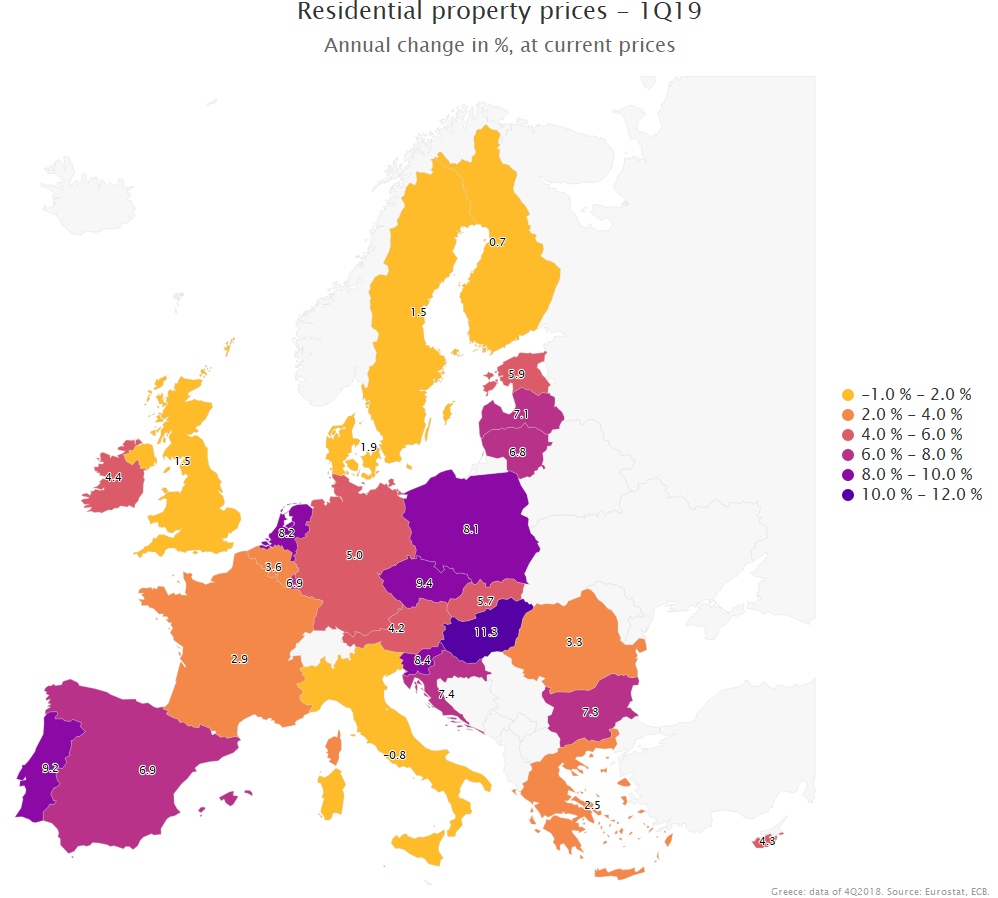Residential property price growth accelerates notably in Vienna in the second quarter of 2019
(, Vienna)OeNB publishes update of International Property Market Review (“Immobilien aktuell – International,” available in German only)
The OeNB’s International Property Market Review examines residential property price growth in Austria as well as in Central, Eastern and Southeastern Europe (CESEE) and in other EU countries.
Residential property prices in Vienna increased by a hefty 9.8% (year on year) in the second quarter of 2019, following a rate of +5.5% in the first quarter. Increases of around 10% were last seen in 2013. In Austria’s other provinces, the trend of slowing price growth continued, as lower rates were recorded for the fourth time in a row: +3.8% in the second quarter of 2019 after +4.1% at the beginning of the year. In Austria as a whole, residential property prices rose by 7.3% on the year in the second quarter of 2019, following a year-on-year increase of 5.0% in the first quarter. The OeNB fundamentals indicator for residential property prices for Vienna rose by 3.2 percentage points to 25.9% against the previous quarter, signaling a further increase in the overvaluation of housing in the capital. For Austria as a whole, the indicator climbed by 1.2 percentage points to 14.1%1.
Housing loans grew by 5.0% (year on year) in June, as borrowing conditions remained favorable.
| Q2 19 | Q1 19 | Q4 18 | Q3 18 | Q2 18 | Q1 18 | Q4 17 | 2018 | 2017 | 2016 | 2015 | 2014 | 2013 | |
|---|---|---|---|---|---|---|---|---|---|---|---|---|---|
| Annual change in % | |||||||||||||
| Austria | 7.3 | 5.0 | 7.4 | 8.0 | 5.0 | 7.3 | 4.7 | 6.9 | 3.8 | 7.3 | 4,1 | 3.5 | 4.7 |
| Austria without Vienna | 3.8 | 4.1 | 8.5 | 9.7 | 6.0 | 10.0 | 7.3 | 8.5 | 4.9 | 9.1 | 5,1 | 3.1 | 2.7 |
| Vienna | 9.8 | 5.5 | 6.7 | 6.5 | 4.2 | 3.5 | 0.3 | 5.2 | 1.5 | 3.8 | 2,2 | 4.2 | 8.7 |
| Quarterly change in % | |||||||||||||
| Austria | 2.9 | 1.4 | 0.1 | 2.8 | 0.6 | 3.8 | 0.6 | x | x | x | x | x | x |
| Austria without Vienna | 0.2 | 0.0 | 1.0 | 2.6 | 0.5 | 4.1 | 2.1 | x | x | x | x | x | x |
| Vienna | 4.8 | 2.3 | -0.6 | 2.9 | 0.7 | 3.5 | -0.7 | x | x | x | x | x | x |
| Index (2000=100) | |||||||||||||
| Austria | 212.1 | 206.1 | 203.3 | 203.2 | 197.6 | 196.4 | 189.3 | 200.1 | 187.2 | 180.4 | 168,1 | 161.4 | 156.0 |
| Austria without Vienna | 194.2 | 193.8 | 193.9 | 192.0 | 187.1 | 186.2 | 178.8 | 189.8 | 174.9 | 166.7 | 152,9 | 145.4 | 141.1 |
| Vienna | 251.9 | 240.3 | 234.8 | 236.1 | 229.4 | 227.7 | 220.1 | 232.0 | 220.4 | 217.2 | 209,2 | 204.6 | 196.3 |
| Source: Data Science Service GmbH (DSS), Vienna University of Technology, Prof. Feilmayr, OeNB. | |||||||||||||
Fast residential property price growth in some euro area countries
Some euro area countries reported sharp increases in house prices, in particular Portugal, the Netherlands, Spain, Luxembourg, Malta and Germany, in the fourth quarter of 2018 and the first quarter of 2019, while Italy saw another decrease in prices.
Residential property prices continue to rise in CESEE
In Central, Eastern and Southeastern Europe (CESEE), the annual increase in residential property prices clearly exceeded the EU average in the fourth quarter of 2018 and the first quarter of 2019. Prices grew particularly strongly in the Czech Republic, Hungary, Poland, Slovenia and Slovakia. While demand for residential property remains high, housing supply has been slow to respond to demand in most CESEE countries. This is also, but not exclusively, due to a shortage of labor in the construction industry.

1The assessment of the situation in real estate markets needs to take into account not only price growth but also other factors, including new mortgage loans, demographic developments, expectations of returns from alternative forms of investment and the expected path of interest rates. The OeNB’s fundamentals indicator shows in how far actual real estate prices deviate from the values justified by underlying fundamental factors. If the factors mentioned above remain above their long-term levels for a protracted period of time, they may signal a potential overheating of the real estate market.
